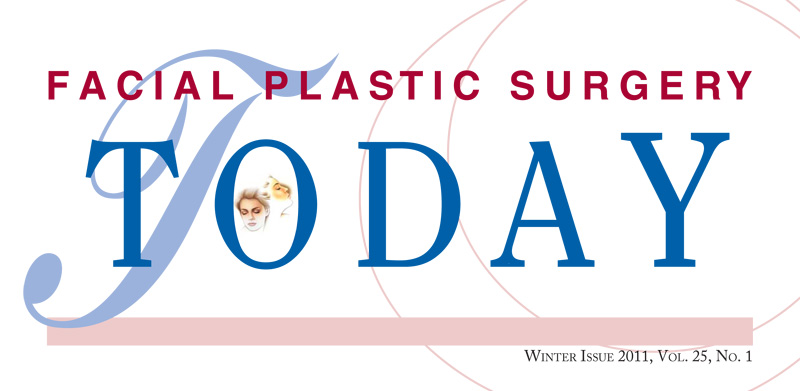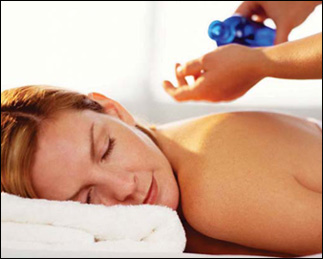 |
Ready for a hot special for the last few cool days of winter?
30% OFF TOTAL FX Laser resurfacing in March!
State of the art skin resurfacing for lines, wrinkles, and sun spots!
Check out this link for an example before-and-after photo:
http://www.realself.com/photo/130742?offset=4&topic_id=39724
Also check out the newsletter below to learn about the benefits of a massage before your facial procedure, whether it's laser rejuvenation, a minilift, fat transfer (our exclusive Growth Factor LiftSM) or an eyelid lift.
For a limited time, get a $100 gift card to the deluxe pampering of your choice at Avalon Salon & Spa with any facial procedure!
Call today to find out more or to schedule a complimentary consultation!
Best wishes as we head into a much anticipated Spring!
Dr. Donath and the entire staff of Cincinnati Facial Plastic Surgery
www.cincyfacialplastics.com

|
 |
| Are you feeling the pressure to look younger? You're not alone |
Whether you are trying to keep your job, get a job, or just avoid aging like your
parents, we all feel the demand to look
our best. Several recent studies show
that both men and women are concerned about their appearance and
willing to take action to improve it.
An interesting survey of 10,000
people by Saga magazine evealed
that
people over 50 are more cognizant regarding their aging |
 |
non-surgical procedures educated about plastic surgery (77 percent), and more use of non-surgical procedures to delay surgical procedures (72 percent).
The most common non-surgical procedure for both men and women was Botox. Overall, these non-surgical procedures increased by 79 percent in 2009 compared to 2008 data. The
economy most likely influenced the growing trend of |
|
appearance, with 62 percent believing they are more likely to be judged on their appearance than previous generations. Cosmetic surgery has nearly doubled when compared to a generation ago.
And men are now 14 times more likely to use anti-wrinkle cream,
with 10 percent currently using some sort of age-defying serum.
The Heat Group surveyed 500 female employees and found that onefifth of working women state they would consider cosmetic surgery to further their career. Approximately 30 percent reported discrimination atwork based on their looks. And 40 percent affirmed that they knew of a co-worker who had been hired or promoted due
to physical attractiveness rather than job performance.
According to facial plastic surgeons surveyed by the American Academy of Facial Plastic and Reconstructive Surgery, the latest trends in 2009 were people requesting cosmetic surgery to remain competitive in the workplace (80 percent agree), patients being more educated about plastic surgery (77 percent), and more use of |
consumers having less-costly, less invasive procedures.
Also, there is a shorter recovery time, which often means more immediate results and a return to work the following day. Typical improvements include reducing frown lines (Botox), softening deep wrinkles (filler injections), and smoothing skin (laser resurfacing, chemical peel, or microdermabrasion).
The most common surgical procedure for women was the facelift; rhinoplasty was the most popular procedure for men. Surgical cosmetic procedures increased by 13 percent and reconstructive procedures also increased by 31 percent in 2009.
Obviously, you are not alone. Acceptance, accessibility, and affordability have played a role in the pressure to look younger. Today, it is more acceptable to fight against the aging process. Noninvasive treatment options have made taking action more affordable and accessible to a wider population. For more information, schedule a consultation appointment with your facial plastic surgeon.
|
|
| Knowing the laser language and the different types. Which one will |
Lasers light amplification by
the stimulated emission of
radiation provide an
excellent option for helping you
achieve a younger, more vibrant
you. How do lasers work? What
procedures use lasers? How can I
benefit from lasers? Find out more
information about what your facial
plastic surgeon has available so you
can discuss your optimal choices at
your next consultation.
Laser introduction
A laser is a beam of light that can
selectively transfer its energy into
tissue to treat the skin. The light beam |
 |
the reticular dermis. Superficial wrinkles and slight pigmentation problems generally originate in the
epidermis. Scars and deep
wrinkles involve the papillary
and reticular layers. Ablative
laser resurfacing can remove
the epidermis and penetrate
into the papillary dermis;
this eliminates the
superficial wrinkles and
blotchy pigmentation.
Extensive scarring and
wrinkles in the reticular dermis
can be made less noticeable
with resurfacing, but not
eliminated entirely. After
resurfacing, during the repair process, your skin rebuilds the tissue allowing a
fresh |
|
can be
varied in its intensity and pulse duration. The
wavelength and power output of a particular
laser determines its medicinal application.
Many procedures can be performed with
different lasers. The choice of the laser depends
upon many factors, including the surgeon's
experience, the size of the area to be treated,
skin type and color, and the expectations of the
patient.
Lasers can be used to reduce wrinkles
around the lips or eyes, even the entire face,
softening fine wrinkles and removing certain
blemishes on the face. This type of resurfacing
may be referred to as laser skin peeling.
The appearance of birthmarks and skin
lesions can be improved by laser resurfacing.
Port-wine stain birthmarks respond remarkably
well to laser treatment. The abnormal blood
vessels that cause these marks are reduced in
size by the laser. This results in a lightening of
the treated area. Skin growths, facial "spider
veins," warts, and some tattoos respond to laser surgery. Most |
situations take more than one laser treatment, but some respond to a single
treatment.
Technological advances will lead to new
applications and new generations of lasers. Talk
to your facial plastic surgeon to see what is
available.
How it works
There are two types of lasers that work very
differently on your skin, ablative and
nonablative. Ablative (skin removing) lasers
produce a powerful beam of bright light that
heats water within the surface layers of the skin
causing both the water and the tissue to
vaporize. The depth of laser resurfacing is
dependent upon the light wavelength, power
utilized, and pulse direction. The carbon
dioxide laser (CO2) and the Erbium YAG laser
are examples of commonly used ablative lasers.
Your skin is made up of the epidermis
(outer layer) and the dermis (underneath).
Within the dermis are two levels, the papillary
dermis and |
new layer to become the skin surface. You may experience some swelling and redness for
several days. Antibiotic ointments may be used
during the healing process. Be sure to follow all
the postoperative directions of the surgeon,
especially using sunblock and avoiding sun
exposure.
The full impact of the laser may not be
apparent for a month or two, especially with
vascular deformities. Additional treatment
sessions will not be scheduled until the healing
process for a particular treatment is complete.
Nonablative or fractionated lasers,
conversely, have lower energy levels than
ablative. The heat of the laser stimulates
collagen production in the dermal layer with
little damage to the epidermis layer. The
collagen growth may improve skin tone,
texture, and fine wrinkles. These lasers usually
require multiple treatments-with little or no
recovery time-to bring about the desired
results. Light-based devices, e.g., Intense
Pulsed Light (IPL), use flashes of light |
|
| DON'T FORGET: LASER SPECIAL! 30% off in March! |
| |
work for you?
(technically not a laser) to stimulate the dermal
tissues. These nonablative treatments may be
referred to as photo rejuvenation.
Although there is little or no downtime
after treatment, your facial plastic surgeon will
still provide postoperative instructions to
maximize your results, such as moisturizing the
area and using sunblock.
Advantages
Rejuvenation treatments with a laser provide
reliable, safe, and effective, outpatient
procedures to minimize the appearance of
damaged or wrinkled skin. Lasers may offer you
and your facial plastic surgeon the following
benefits:
- Performed usually with a local anesthesia
- Little or no bleeding, reducing risk of
infection
- Controlled precisely, limiting damage to
surrounding, healthy skin
- Improved restorative results
These advantages, combined with the
economic climate, have led to increased
popularity for laser resurfacing. Compared with
2008, laser resurfacing increased in 2009 by 57
percent, according to a survey published by the
American Academy of Facial Plastic and
Reconstructive Surgery, making it the fourth
most popular cosmetic procedure of 2009.
While it cannot turn back the clock, laser
resurfacing can renew your skin and take years
off of your appearance. You may be an ideal
candidate if you suffer from skin damaged from
the sun, uneven pigmentation, fine line
wrinkles (e.g., crow's feet, smile lines), acne
scars, or superficial skin cancers. Make an
appointment with your facial plastic surgeon
for a skin evaluation and to discuss what
options may meet your needs. |
ASK THE SURGEON
 Does pressurized oxygen therapy help you to heal faster?
The concept of Hyperbaric Oxygen Therapy (HBOT) dates back to the
1600s; however, it wasn't until the 1960s that the Undersea and Hyperbaric
Medical Society formed guidelines regarding this type of treatment. The
first chamber was constructed in the 1970s. Does pressurized oxygen therapy help you to heal faster?
The concept of Hyperbaric Oxygen Therapy (HBOT) dates back to the
1600s; however, it wasn't until the 1960s that the Undersea and Hyperbaric
Medical Society formed guidelines regarding this type of treatment. The
first chamber was constructed in the 1970s.
Healing cannot take place in the body without the appropriate oxygen
levels in the tissues. While most people have adequate oxygen—unless you
have circulatory problems—the extra oxygen from HBOT dissolves into all
of the body's fluids and enhances the white blood cells' ability to fight infection. It promotes
new capillary development and new connective tissue. Talk to your facial plastic surgeon for
more information.
HEALTH TIP
 Whether it is the cold, whipping wind outside or the hot, blasting air
inside, your skin will need some extra care over the winter months. To
combat the weather, choose a heavier moisturizer to apply daily. Look for
lotions containing "humectants," which are a class of substances (e.g.,
glycerine, sorbitol, alpha-hydroxy acids) that attract moisture to your skin.
You may want to try an ointment moisturizer that is oil-based, rather than
the water-based cream you use in the spring and summer. Just be sure the
oil is appropriate for the face—avocado oil, mineral oil, primrose oil, or
almond oil; usually the label will say nonclogging. These thicker lotions will create a protective
layer on the skin that retains more moisture. Whether it is the cold, whipping wind outside or the hot, blasting air
inside, your skin will need some extra care over the winter months. To
combat the weather, choose a heavier moisturizer to apply daily. Look for
lotions containing "humectants," which are a class of substances (e.g.,
glycerine, sorbitol, alpha-hydroxy acids) that attract moisture to your skin.
You may want to try an ointment moisturizer that is oil-based, rather than
the water-based cream you use in the spring and summer. Just be sure the
oil is appropriate for the face—avocado oil, mineral oil, primrose oil, or
almond oil; usually the label will say nonclogging. These thicker lotions will create a protective
layer on the skin that retains more moisture.
And even though the suns rays are not as strong, it doesn't mean you don't need sunscreen.
Apply a broad-spectrum sunscreen to your face 30 minutes before going outside.
Dig out your humidifiers—they put moisture back into the air, which helps prevent your
skin from drying out.
Stick with your skin cleansing routine, but don't overdo it with masks, alcohol-based
toners, and harsh peels. If your skin is dry, these products can worsen the dry area and make it
uncomfortable. Instead, look for a mild foaming cleanser, "deep hydrating" masks, and a toner
with no alcohol. Avoid anything clay based, which tends to draw moisture out.
WHAT'S NEW?
 Dysport gained approval from the United States Food and Drug
Administration for cosmetic use in July 2009 and is still commanding a lot
of attention as an alternative to Botox. Prescription Dysport is an injection
of botulinum toxin used to temporarily improve the look of moderate to
severe frown lines between the eyebrows. Dysport stops the signal from the
nerve to the muscles, resulting in a reduction of muscle activity and
temporarily preventing contraction of the muscles that cause frown lines.
While Botox has had a strong hold on the injectable toxin market since
April 2002, studies are underway to look at how the two compare. Talk to your facial plastic
surgeon to find out which is the better option for you. Dysport gained approval from the United States Food and Drug
Administration for cosmetic use in July 2009 and is still commanding a lot
of attention as an alternative to Botox. Prescription Dysport is an injection
of botulinum toxin used to temporarily improve the look of moderate to
severe frown lines between the eyebrows. Dysport stops the signal from the
nerve to the muscles, resulting in a reduction of muscle activity and
temporarily preventing contraction of the muscles that cause frown lines.
While Botox has had a strong hold on the injectable toxin market since
April 2002, studies are underway to look at how the two compare. Talk to your facial plastic
surgeon to find out which is the better option for you.
|
|
| Innovative ways to optimize your healing |
Your facial plastic surgeon seeks
to combine state of the art
reconstructive and cosmetic
services with nurturance and inclusive
care. Your physician is treating the
whole patient with supplementary
services to reduce nervousness, enhance
healing, and maximize patient
satisfaction. The following suggestions
may help you sail more smoothly
through your next procedure-from
pre-op to post-op.
Research has shown that the
more relaxed and comfortable a patient
is before surgery, the better his or her
convalescence. Your facial plastic
surgeon may recommend a few days |
 |
Mount Sinai
researchers reviewed 20 different
studies on hypnosis and surgical pain
and found that for those patients
susceptible to its effects, adding
hypnosis to standard post-surgical
care sped recovery in terms of pain,
anxiety, and the need for painkillers.
A less well-known treatment is
hyperbaric oxygen therapy (HBOT).
The patient is placed into a chamber
to breathe 100 percent oxygen at
greater than normal atmospheric
pressures (usually up to two times
greater) for an hour or so. Normally, we breathe approximately 20 percent increased pressure combined with |
|
before surgery or the day of surgery such things as aromatherapy, relaxing
music, guided imagery tapes, reflexology, or acupressure. A massage can
improve circulation, deepen relaxation, and provide an increased sense of
physical and emotional well-being. This relaxed state helps minimize the
release of epinephrine and cortisone; these hormones increase the body's
tendency to swell and bruise. Your physician may also recommend these
same treatments to relieve pain and promote healing after your procedure.
Hypnosis is a trancelike state characterized by extreme suggestibility,
relaxation, and heightened imagination. Some patients use selfhypnosis
to visualize the success of the surgery and the success of the
recovery. They focus on the flawless procedure, the healing body, the ease of blood flow, and the return to
normal energy levels. |
an increase in oxygen, dissolves oxygen
in the blood plasma and in all body cells, tissues, and fluids, at up to 10
times normal concentration. This increased oxygen to tissues stimulates
growth and repair.
Your facial plastic surgeon may recommend various homeopathic
remedies or dietary supplements, e.g., arnica or bromelain, which may
help minimize swelling and bruising. Do not take any pills or supplements
without the approval of your doctor, as they can impede the healing
process.
Discuss with your facial plastic surgeon how you can plan for a
stress-free experience that will allow your body to respond and recover
optimally after your next treatment or surgery.
|
|
DON'T FORGET: $100 GIFT CARD TO AVALON SALON AND SPA with any facial procedure, for a limited time!
Get a massage before your procedure and a facial, hair styling or coloring, or a manicure/pedicure after!
|
|
513-891-LIFT (5438)
www.cincyfacialplastics.com
 |
|
Cincinnati Facial Plastic Surgery | 7763 Montgomery Road, Suite A, Cincinnati, OH 45236 | 513-891-LIFT (5438) |
|
|
|